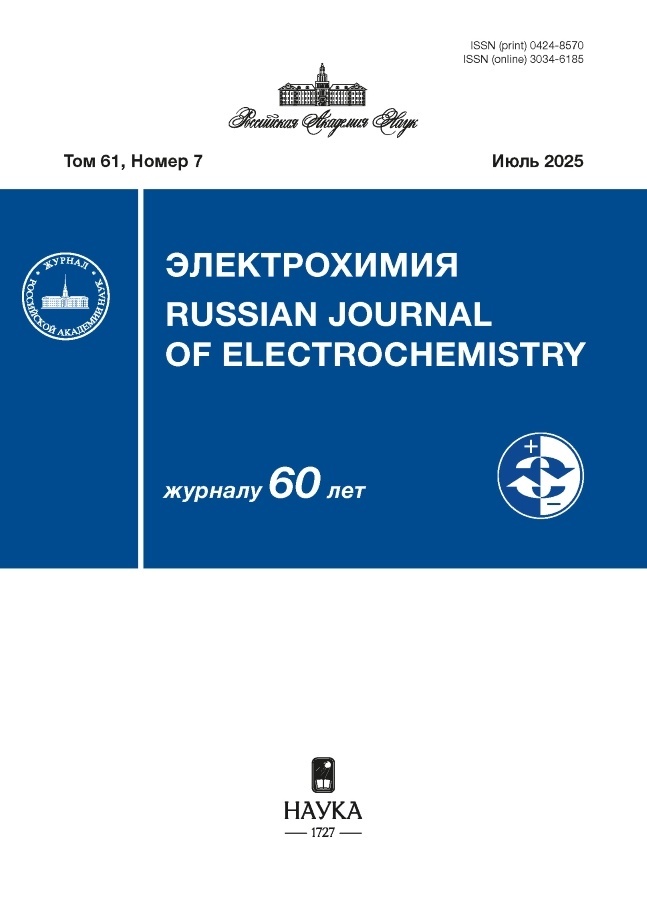Electrodeposition of Photosensitive Layers Based on Conducting Polymers and Zinc Phthalocyaninate, Their Structure and Photoelectrical Properties
- Authors: Gribkova O.L.1, Kabanova V.A.1, Kormshchikov I.D.2, Tameev A.R.1, Nekrasov A.A.1
-
Affiliations:
- A.N. Frumkin Institute of Physical Chemistry and Electrochemistry of the Russian Academy of Sciences
- Lomonosov Moscow State University
- Issue: Vol 60, No 6 (2024)
- Pages: 430-441
- Section: Articles
- URL: https://modernonco.orscience.ru/0424-8570/article/view/671329
- DOI: https://doi.org/10.31857/S0424857024060053
- EDN: https://elibrary.ru/PUULBI
- ID: 671329
Cite item
Abstract
Photosensitive hybrid layers were obtained by electrochemical polymerization of pyrrole and 3,4-ethylenedioxythiophene (EDOT) in the presence of water-soluble sodium salt of zinc octa(3ʹ,5ʹ-dicarboxyphenoxy)phthalocyaninate (ZnPc) containing 16 ionogenic carboxylate groups. It was found that the process of electrodeposition of hybrid layers most effectively occurs in galvanostatic and potentiostatic modes on the sublayer of the PEDOT-polyacid complex. The electronic and chemical structure and morphology of hybrid layers of polypyrrole (PPy) obtained in the presence of ZnPc were studied. Possible reasons are considered that the measured values of photosensitivity and external quantum yield of charge carrier generation in PPy-ZnPc are several times higher than in PEDOT-ZnPc.
Full Text
About the authors
O. L. Gribkova
A.N. Frumkin Institute of Physical Chemistry and Electrochemistry of the Russian Academy of Sciences
Author for correspondence.
Email: oxgribkova@gmail.com
Russian Federation, Moscow
V. A. Kabanova
A.N. Frumkin Institute of Physical Chemistry and Electrochemistry of the Russian Academy of Sciences
Email: oxgribkova@gmail.com
Russian Federation, Moscow
I. D. Kormshchikov
Lomonosov Moscow State University
Email: oxgribkova@gmail.com
Russian Federation, Moscow
A. R. Tameev
A.N. Frumkin Institute of Physical Chemistry and Electrochemistry of the Russian Academy of Sciences
Email: oxgribkova@gmail.com
Russian Federation, Moscow
A. A. Nekrasov
A.N. Frumkin Institute of Physical Chemistry and Electrochemistry of the Russian Academy of Sciences
Email: secp@elchem.ac.ru
Russian Federation, Moscow
References
- Симон, Ж., Андре, Ж.-Ж. Молекулярные полупроводники. Фотоэлектрические свойства и солнечные элементы. М.: Мир, 1988. p. 344.
- Gsänger, M., Bialas, D., Huang, L., Stolte, M., and Würthner, F., Organic Semiconductors based on Dyes and Color Pigments, Advanced Mater., 2016, vol. 28, no. 19, p. 3615. https://doi.org/10.1002/adma.201505440
- Ray, A.K., Mukherjee, D., and Sarkar, S., Phthalocyanines: A Class of Organic Photoconductive Materials, Photoconductivity and Photoconductive Mater.: Fundamentals, Techniques and Applications: Vol. 1 and 2, 2022, p. 831. https://doi.org/10.1002/9781119579182.ch21
- Bao, Z., Lovinger, A.J., and Dodabalapur, A., Highly ordered vacuum-deposited thin films of metallophthalocyanines and their applications in field-effect transistors, Advanced Mater., 1997, vol. 9, no. 1, p. 42. https://doi.org/10.1002/adma.19970090108
- Odintsova, E.G., Petrenko, V.E., Kolker, A.M., and Borovkov, N.Y., Molecular origin of structural defects in the zinc phthalocyanine film, Phys. Chem. Chem. Phys., 2022, vol. 24, no. 33, p. 19956. https://doi.org/10.1039/D2CP01221A
- Kabanova, V.A., Gribkova, O.L., Tameev, A.R., and Nekrasov, A.A., Hole transporting electrodeposited PEDOT-polyelectrolyte layers for perovskite solar cells, Mendeleev Commun., 2021, vol. 31, no. 4, p. 454. https://doi.org/10.1016/j.mencom.2021.07.005
- Истакова, О.И., Конев, Д.В., Медведева, Т.О., Золотухина, Е.В., Воротынцев, М.А. Эффективность процесса электрополимеризации пиррола в различных условиях. Электрохимия. 2019. Т. 55. С. 85. https://doi.org/10.1134/S0424857018130248
- Qiu, Y.-J. and Reynolds, J. R., Electrochemically initiated chain polymerization of pyrrole in aqueous media, J. Polymer Sci. Part A: Polymer Chem., 1992, vol. 30, no. 7, p. 1315. https://doi.org/10.1002/pola.1992.080300709
- Muthuraman, G., Shim, Y.-B., Yoon, J.-H., and Won, M.-S., Simultaneous immobilization of cobalt tetrasulfonated phthalocyanine during electropolymerization of pyrrole in presence of surfactants: a study of film morphology and its conductivity, Synthetic Metals, 2005, vol. 150, no. 2, p. 165. https://doi.org/10.1016/j.synthmet.2005.02.002
- Singh, V.V., Gupta, G., Sharma, R., Boopathi, M., Pandey, P., Ganesan, K., Singh, B., Tiwari, D. C., Jain, R., and Vijayaraghavan, R., Detection of chemical warfare agent Nitrogen Mustard–1 based on conducting polymer phthalocyanine nanorod modified electrode, Synthetic Metals, 2009, vol. 159, no. 19, p. 1960. https://doi.org/10.1016/j.synthmet.2009.07.001
- Patois, T., Sanchez, J.B., Berger, F., Fievet, P., Segut, O., Moutarlier, V., Bouvet, M., and Lakard, B., Elaboration of ammonia gas sensors based on electrodeposited polypyrrole – Cobalt phthalocyanine hybrid films, Talanta, 2013, vol. 117, p. 45. https://doi.org/10.1016/j.talanta.2013.08.047
- Sizun, T., Patois, T., Bouvet, M., and Lakard, B., Microstructured electrodeposited polypyrrole-phthalocyanine hybrid material, from morphology to ammonia sensing, J. Mater. Chem., 2012, vol. 22, no. 48, p. 25246. https://doi.org/10.1039/c2jm35356c
- Nguyen, V.C. and Potje-Kamloth, K., Electrical and chemical sensing properties of doped polypyrrole/gold Schottky barrier diodes, Thin Solid Films, 1999, vol. 338, no. 1–2, p. 142. https://doi.org/10.1016/S0040-6090(98)01060-8
- Nguyen, Van C. and Potje-Kamloth, K., Electrical and NOx gas sensing properties of metallophthalocyanine-doped polypyrrole/silicon heterojunctions, Thin Solid Films, 2001, vol. 392, no. 1, p. 113. https://doi.org/10.1016/S0040-6090(01)00837-9
- Petrov, A.A., Lukyanov, D.A., Kopytko, O.A., Novoselova, J.V., Alekseeva, E. V., and Levin, O. V., Inversion of the Photogalvanic Effect of Conductive Polymers by Porphyrin Dopants, Catalysts, 2021, vol. 11, no. 6, p. 729. https://doi.org/10.3390/catal11060729
- Грибкова, О.Л., Кабанова, В.А., Ягодин, А.В., Аверин, А.А., Некрасов, А.А. Водорастворимый фталоцианин с ионогенными группами как молекулярная матрица для электрополимеризации 3,4-этилендиокситиофена. Электрохимия. 2022. Т. 58. С. 711. [Gribkova, O.L., Kabanova, V.A., Yagodin, A.V., et al., Water-Soluble Phthalocyanine with Ionogenic Groups as a Molecular Template for Electropolymerization of 3,4-Ethylenedioxythiophene, Russ. J. Electrochem., 2022, vol. 58, p. 957.] https://doi.org/10.1134/S1023193522110076
- Liu, W., Jensen, T.J., Fronczek, F.R., Hammer, R.P., Smith, K.M., and Vicente, M.G.H., Synthesis and Cellular Studies of Nonaggregated Water-Soluble Phthalocyanines, J. Medic. Chem., 2005, vol. 48, no. 4, p. 1033. https://doi.org/10.1021/jm049375b
- Gribkova, O.L., Kabanova, V. A., and Nekrasov, A.A., Electrodeposition of thin films of polypyrrole-polyelectrolyte complexes and their ammonia-sensing properties, J. Solid State Electrochem., 2020, vol. 24, no. 11, p. 3091. https://doi.org/10.1007/s10008-020-04766-0
- Kabanova, V., Gribkova, O., and Nekrasov, A., Poly(3,4-ethylenedioxythiophene) Electrosynthesis in the Presence of Mixtures of Flexible-Chain and Rigid-Chain Polyelectrolytes, Polymers, 2021, vol. 13, no. 22, p. 3866. https://doi.org/10.3390/polym13223866
- Lokesh, K.S. and Adriaens, A., Electropolymerization of palladium tetraaminephthalocyanine: Characterization and supercapacitance behavior, Dyes and Pigments, 2015, vol. 112, p. 192. https://doi.org/10.1016/j.dyepig.2014.06.034
- Aroca, R., Dilella, D.P., and Loutfy, R.O., Raman spectra of solid films-I. Metal-free phthalocyanine, J. Phys. and Chem. Solids, 1982, vol. 43, no. 8, p. 707. https://doi.org/10.1016/0022-3697(82)90235-9
- Gribkova, O.L., Kabanova, V.A., Iakobson, O.D., and Nekrasov, A.A., Spectroelectrochemical investigation of electrodeposited polypyrrole complexes with sulfonated polyelectrolytes, Electrochim. Acta, 2021, vol. 382, p. 138307. https://doi.org/10.1016/j.electacta.2021.138307
- Gribkova, O.L., Iakobson, O.D., Nekrasov, A.A., Cabanova, V.A., Tverskoy, V.A., Tameev, A.R., and Vannikov, A.V., Ultraviolet-Visible-Near Infrared and Raman spectroelectrochemistry of poly(3,4-ethylenedioxythiophene) complexes with sulfonated polyelectrolytes. The role of inter- and intra-molecular interactions in polyelectrolyte, Electrochim. Acta, 2016, vol. 222, p. 409. https://doi.org/10.1016/j.electacta.2016.10.193
- Potje-Kamloth, K., Chemical Gas Sensors Based on Organic Semiconductor Polypyrrole, Critical Rev. in Analytical Chem., 2002, vol. 32, no. 2, p. 121. https://doi.org/10.1080/10408340290765489
- Zafar, Q., Fatima, N., Karimov, K.S., Ahmed, M.M., and Sulaiman, K., Realizing broad-bandwidth visible wavelength photodiode based on solution-processed ZnPc/PC71BM dyad, Optical Mater., 2017, vol. 64, p. 131. https://doi.org/10.1016/j.optmat.2016.12.001
- Nath, D., Dey, P., Joseph, A.M., Rakshit, J.K., and Roy, J.N., CuPc/C60 heterojunction for high responsivity zero bias organic red-light photodetector, Appl. Phys. A: Mater. Sci. and Processing, 2020, vol. 126, no. 8, p. 627. https://doi.org/10.1007/s00339-020-03806-w
Supplementary files
















